- 1阿里云ECS开放80端口方法_阿里云开启80端口
- 2HT66F018定时器0(STM)定时器/计数器功能使用教程_合泰定时器如何设置
- 3微信小游戏云开发——云函数创建、应用、相关问题_微信云函数creatematchrule
- 4栈的基本操作_栈先进后出,单链表
- 5OpenCV实现物体识别和追踪_opencv识别物体
- 6Element ui 的组件弹窗 el-dialog点击的时候全屏变灰问题解决_el-dialog显示的时候背景置灰
- 7docker安装_docker安装qq
- 8解决GitHub无法访问的问题:手动修改hosts文件与使用SwitchHosts工具_github host
- 9统治扩散模型的U-Net要被取代了,谢赛宁等引入Transformer提出DiT_dits算法
- 10一文带你了解MySQL之Log Buffer_mysql log buffer
树莓派4B-搭建一个本地车牌识别服务器
赞
踩
实现目标:
一、设备自启后能够获得服务的ip与端口号,用于计算机连接设备;
二、计算机可以通过服务ip与端口访问设备服务;
三、上传需要处理的数据,返回结果反馈给用户;
四、上传到服务器的数据不会导致设备内存耗尽,自动删除多余的数据;
进阶(未实现):
五、提供用户登陆功能,设备支持唯一damin管理员用户。其他用户可注册;
六、提供登陆界面,用户通过登陆界面输入用户名与密码登录;
七、支持已处理的数据记录在设备数据库当中,提供web页面可查;
八、查询的历史数据支持查看:数据处理时间、处理前上传图片和处理后车牌结果。
使用到的工具与方法
一、systemctl自启服务
二、oled
二、python
三、flask
四、bootstrap框架
五、hyperlpr车牌识别的v1版本
实现过程:
一、配置自启服务,开机显示服务ip与端口
使用systemctl配置开机自启由oled显示ip与端口(在前面另一篇文章)。

二、将基于flask的web程序加入到run.sh执行脚本当中
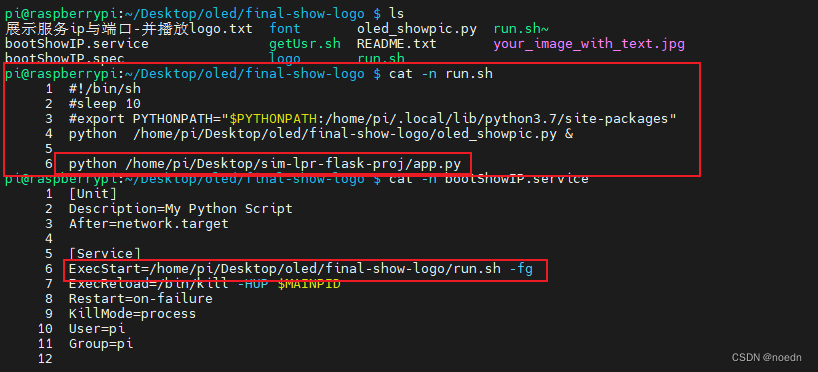
前提是bootShowIP.service文件已经放到/lib/usr/systemd/system目录当中并已启用:
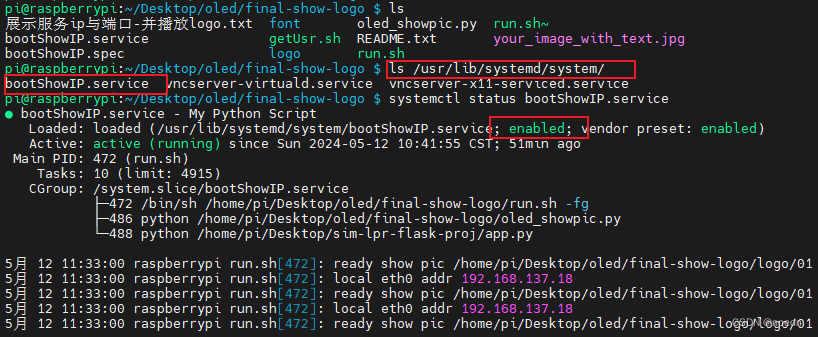
三、在将flask程序部署到树莓派上前,在本地进行了测试。
1、本地可以正常安装使用hyperlpr3,但是在设备上运行时提示由于无法安装onnxruntime导致的无法使用车牌识别功能。
2、无法安装onnxruntime可能是因为onnxruntime没有支持设备的处理器架构的版本。尝试安装hyperlpr v1成功:
python -m pip install -i https://pypi.tuna.tsinghua.edu.cn/simple hyperlpr
#防止下载过慢,使用-i指定下载镜像
- 1
- 2
3、由于hyperlpr v1版本比较旧,依赖的numpy版本也比较旧,如果直接安装最新的numpy会导致无法使用:
尝试解决:
pip install -i https://pypi.tuna.tsinghua.edu.cn/simple --upgrade --force-reinstall numpy
- 1
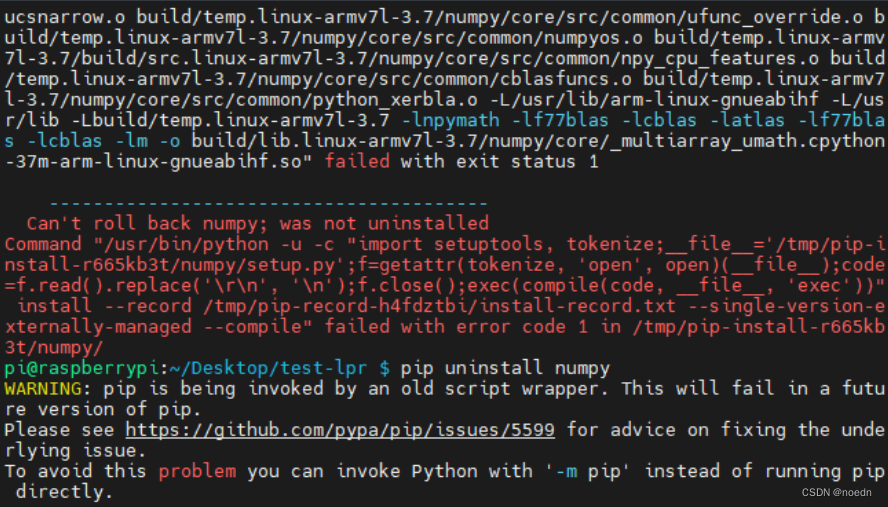
安装失败,按提示“Can't roll back numpy; was not uninstalled”,卸载pip uninstall numpy
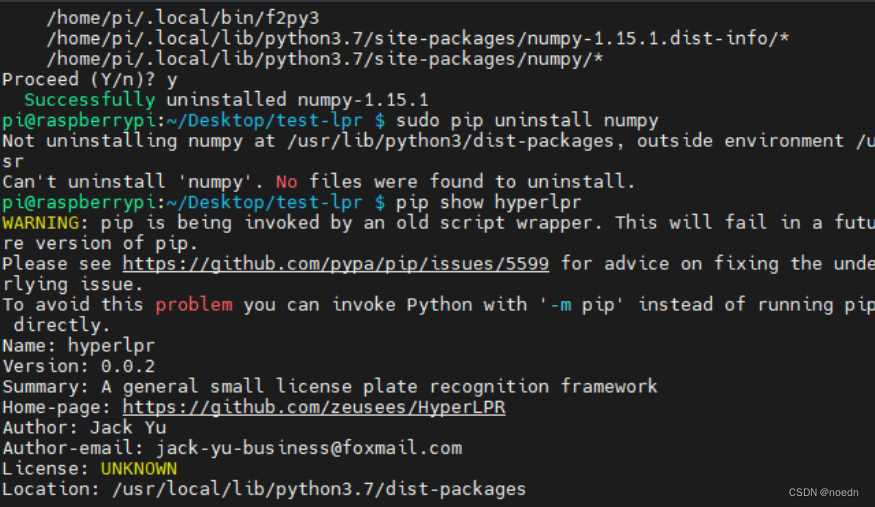
卸载之后发现hyperlpr正常了,并且已经存在numpy,可能是安装了多次
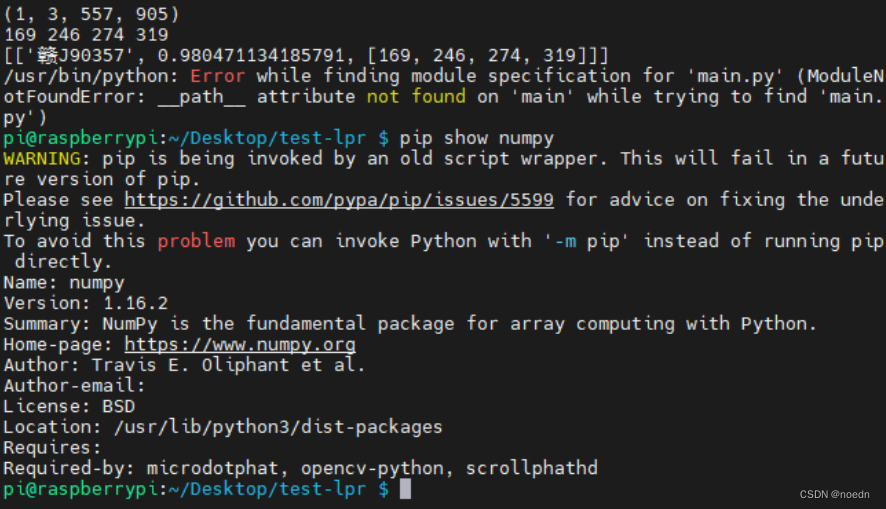
四、测试安装的hyperlpr模块正常后,将以hyperlpr作为后端的falsk程序部署到树莓派
车牌识别系统主页:
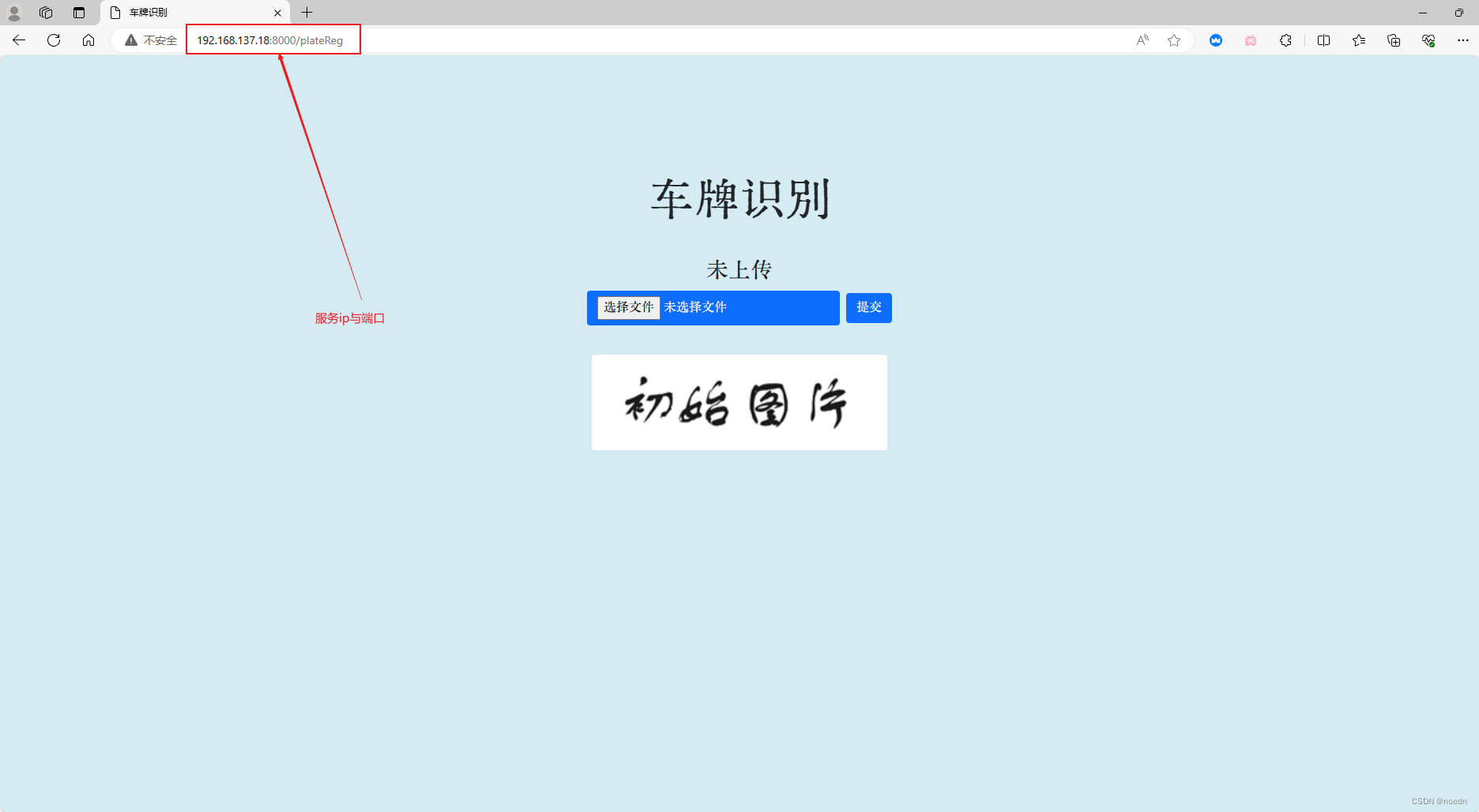
提交待识别车牌:
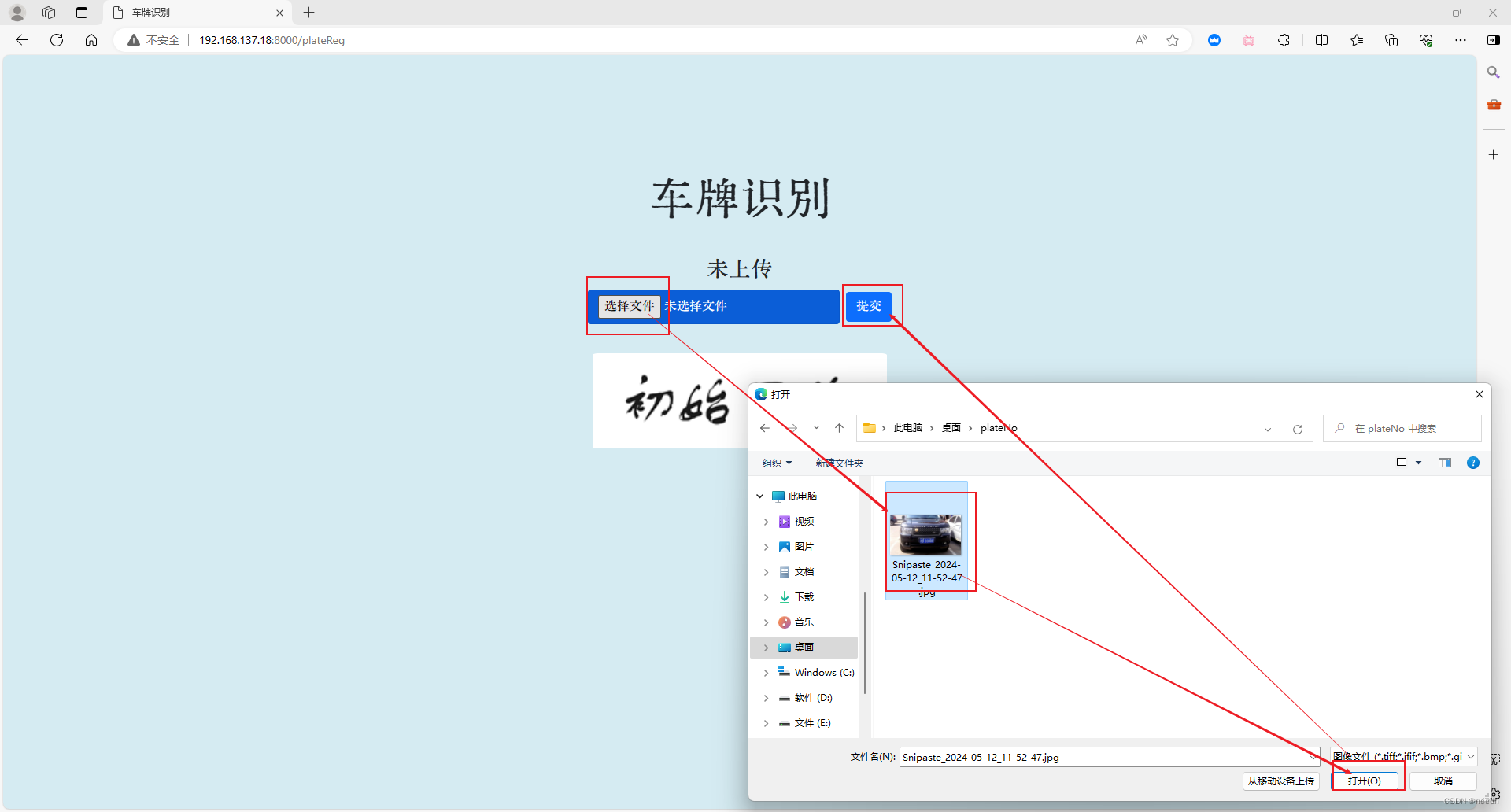
获取车牌识别结果与车牌抠图:
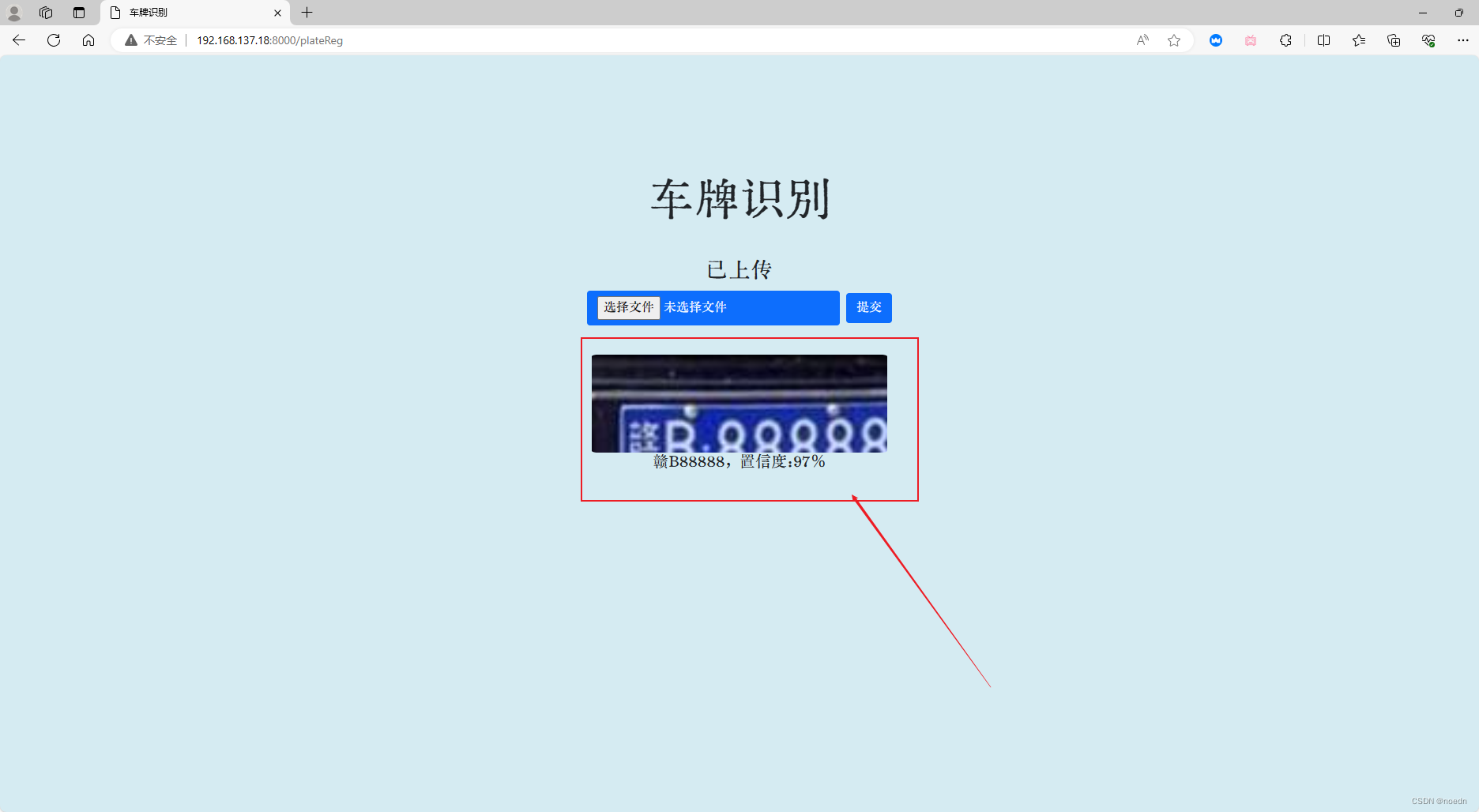
所有源代码
一、项目代码目录结构:
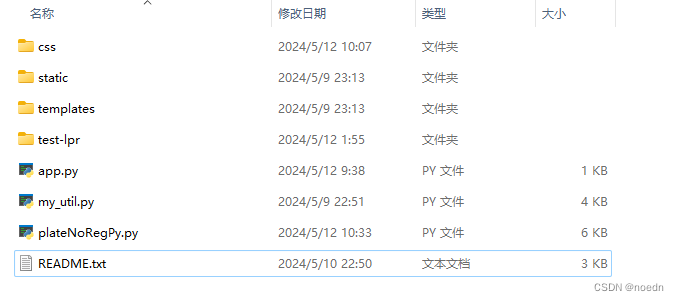
目录文件夹与文件作用说明:
1、css文件夹是boostrap框架的静态文件,用于控制web页面的样式,可以从bootstrap快捷简单的获得美观的表单;
2、static文件夹是字体(目录fonts)、web页面默认展示图片(目录src)、保存用户上传图片和经过处理的图片结果保存目录(目录img);
3、templates文件夹是web页面的html文件保存目录;
4、app.py文件是flask程序的入口函数文件;
5、mu_util.py文件是本人收集实现的一些工具函数文件;
6、plateNoRegPy.py文件是基于hyperlpr的车牌识别处理实现代码文件。
二、hyperlpr模块测试文件夹目录:
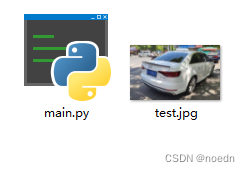
from hyperlpr import *
import cv2
if __name__ == '__main__':
image = cv2.imread("test.jpg")
# 打印识别结果
lpr_result = HyperLPR_plate_recognition(image)
print("[0]")
print(lpr_result[0])
result = lpr_result[0]
print("plateNo:")
print(lpr_result[0][0])
print("location:")
print("x1{},y1{},x2{},y2{}".format(result[2][0], result[2][1], result[2][2], result[2][3]))
- 1
- 2
- 3
- 4
- 5
- 6
- 7
- 8
- 9
- 10
- 11
- 12
- 13
- 14
- 15
三、css文件中的文件由bootstrap中下载
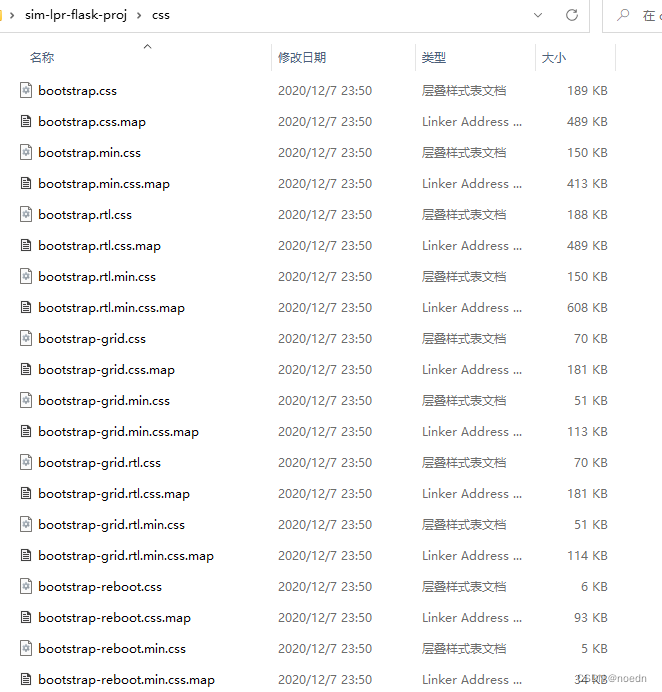
四、static文件夹
1、fonts文件夹

2、img文件夹,程序第一次使用前为空

3、src文件夹

五、templates文件夹

<!DOCTYPE html> <html lang="zh-CN"> <head> <meta charset="UTF-8"> <title>车牌识别</title> <link rel="stylesheet" href="/static/css/bootstrap.css"> <style> /*static 文件夹是默认用于存放静态文件的,比如 CSS、JavaScript、图片和字体文件等。 Flask 会自动为 static 文件夹下的所有文件提供静态文件的路由,使得这些文件可以被直接访问, 而不需要你为每个文件单独编写路由。*/ @font-face { font-family: 'KingHwa'; /* 自定义字体名称 */ /*此处将字体文件加入到static文件夹当中,就省去了编写路由的工作,ttf文件对应路由格式truetype*/ src: url('../static/fonts/KingHwa_OldSong.ttf') format('truetype');/* 字体文件路径和格式 */ font-weight: normal; font-style: normal; } body { background-color: rgba(173, 216, 230, 0.5); /*设置页面背景颜色*/ font-family: "KingHwa", sans-serif; /*设置字体*/ } .center-image { /*position: fixed;*/ display: block; margin-top: 4%; margin-left: 40%; margin-right: 40%; border-radius: 4%; /* 设置圆角大小 */ width: 20%; /* 你可以根据需要调整宽度 */ } .center-bnt { /*position: fixed;*/ display: block; {#margin-top: 10%;#} margin-top: 5%; margin-left: 45%; margin-right: 45%; width: 10%; /* 你可以根据需要调整宽度 */ } .rounded-font { display: block; margin-top: 8%; border-radius: 2%; /* 设置圆角大小 */ font-size: 360%; /* 设置字体大小 */ text-align: center; /* 将文本居中 */ } #backToTop { position: fixed; bottom: 20px; right: 30px; z-index: 99; border: none; outline: 1px solid black;/*设置轮廓*/ background-color: rgba(0, 0, 230, 0.5); color: white; cursor: pointer; padding: 4px 5px; border-radius: 2px;/*设置圆角*/ } .default-img { /*position: fixed;*/ display: block; {#margin-top: 10%;#} {#margin-top: 5%;#} margin-left: 30%; margin-right: 30%; width: 20%; /* 你可以根据需要调整宽度 */ border-radius: 2%;/*设置圆角*/ } .back-home { position: fixed; bottom: 15px; /* 初始时,将元素移出视口 */ right: 100px; /* 其他样式 */ } </style> </head> <h1 class="rounded-font">车牌识别</h1> <body> {# <form style="width:100%;margin:2% auto;" method="post">#} {# <button type="submit" class="btn btn-primary center-bnt" style="font-size: 150%">提交图片文件</button>#} {# </form>#} <center> <div class="body-container"> <div class="jumbotron"> <form style="width:100%;margin:2% auto;" method="post" enctype = "multipart/form-data"> <h3> {{ data.success }} </h3> <input class = "btn btn-primary" type="file" name="image" accept="image/*"> <input class = "btn btn-primary" type="submit"> </form> <img src="static/img/{{ name }}" alt="{{ name }}" class="default-img"> {% for d in data.predictions %} <h5> {{ d.label}}, 置信度:{{d.probability }}% </h5> {% endfor %} </div> </div> </center> {# <a href="{{ url_for('process_plateReg')}}" class="back-home">返回首页</a>#} {# <button onclick="topFunction()" id="backToTop" title="回到顶部">#} {# <img src="{{ url_for('send_image', path='src/toTop.jpg') }}" alt="返回顶部">#} {# </button>#} <script> function topFunction() { window.scrollTo(0, 0); } </script> </body> </html>
- 1
- 2
- 3
- 4
- 5
- 6
- 7
- 8
- 9
- 10
- 11
- 12
- 13
- 14
- 15
- 16
- 17
- 18
- 19
- 20
- 21
- 22
- 23
- 24
- 25
- 26
- 27
- 28
- 29
- 30
- 31
- 32
- 33
- 34
- 35
- 36
- 37
- 38
- 39
- 40
- 41
- 42
- 43
- 44
- 45
- 46
- 47
- 48
- 49
- 50
- 51
- 52
- 53
- 54
- 55
- 56
- 57
- 58
- 59
- 60
- 61
- 62
- 63
- 64
- 65
- 66
- 67
- 68
- 69
- 70
- 71
- 72
- 73
- 74
- 75
- 76
- 77
- 78
- 79
- 80
- 81
- 82
- 83
- 84
- 85
- 86
- 87
- 88
- 89
- 90
- 91
- 92
- 93
- 94
- 95
- 96
- 97
- 98
- 99
- 100
- 101
- 102
- 103
- 104
- 105
- 106
- 107
- 108
六、app.py
from flask import Flask,render_template,request,redirect,send_file import os import plateNoRegPy app = Flask(__name__) # 设置配置 UPLOAD_FOLDER = os.path.join(app.root_path, 'static', 'img') app.config['UPLOAD_FOLDER'] = UPLOAD_FOLDER SOURCE_FOLDER = os.path.join(app.root_path, 'static', 'src') app.config['SOURCE_FOLDER'] = SOURCE_FOLDER # 注册路由和其他配置 app.register_blueprint(plateNoRegPy.blueprint) # 车牌图片识别蓝图注册 @app.route('/src/<path:path>')#网页的所有文件都是来自服务器 def send_image(path): return send_file(path, mimetype='image/jpeg') @app.route('/') def hello_world(): # put application's code here return redirect('/plateReg')#跳转车牌识别 return 'Hello World!' if __name__ == '__main__': # app.run() app.run(host='0.0.0.0', port=8000)#服务访问ip与端口
- 1
- 2
- 3
- 4
- 5
- 6
- 7
- 8
- 9
- 10
- 11
- 12
- 13
- 14
- 15
- 16
- 17
- 18
- 19
- 20
- 21
- 22
- 23
- 24
- 25
- 26
- 27
- 28
七、plateNoRegPy.py
# 功能实现模型来源 # hyperlpr3在树莓派上可能无法安装 https://github.com/szad670401/HyperLPR?tab=readme-ov-file # https://github.com/szad670401/HyperLPR/tree/v1 import cv2 # import hyperlpr3 as lpr3 from hyperlpr import * from PIL import Image from flask import request, url_for, render_template, redirect, Blueprint, current_app from my_util import Logger, copy_file, delete_files import os import random # initialize our Flask application and the lpr object blueprint = Blueprint('processPlatNoImg', __name__) lprObject = None loger = Logger() default_pic_name = "defaultPlate.jpg" def init_default_source(): # 删除多余的图片 max_files_allowed = 30 #后续拷贝一个默认图片,加上上传图片,实际文件夹当中有32个文件 delete_files(current_app.config['UPLOAD_FOLDER'], max_files_allowed) # 默认图片拷贝 source_path = os.path.join(current_app.config['SOURCE_FOLDER'], default_pic_name) dest_path = os.path.join(current_app.config['UPLOAD_FOLDER'], default_pic_name) if not os.path.exists(dest_path) or not os.path.isfile(dest_path): copy_file(source_path, dest_path) # Instantiate object def load_object(): # 默认图片拷贝 source_path = os.path.join(current_app.config['SOURCE_FOLDER'], default_pic_name) dest_path = os.path.join(current_app.config['UPLOAD_FOLDER'], default_pic_name) copy_file(source_path, dest_path) global lprObject lprObject = HyperLPR_plate_recognition ''' def load_object3(): # 默认图片拷贝 source_path = os.path.join(current_app.config['SOURCE_FOLDER'], default_pic_name) dest_path = os.path.join(current_app.config['UPLOAD_FOLDER'], default_pic_name) copy_file(source_path, dest_path) global lprObject lprObject = lpr3.LicensePlateCatcher() ''' def prepare_image(image): loger.debug("Preparing image"+image) image = cv2.imread(image) return image def crop_image(image1, image2, x1, y1, x2, y2): # 打开图片 img = Image.open(image1) # 截取图片,参数为左上角和右下角的坐标 cropped_img = img.crop((x1, y1, x2, y2)) # 保存截取的图片 cropped_img.save(image2) loger.debug("recognize plateNo: " + image2) @blueprint.route('/plateReg', methods=['GET', 'POST']) # 访问的路径 def process_plateReg(): init_default_source() data = {"success": "未上传"} title = "Upload an image" name = default_pic_name if request.method == "POST": if request.files.get("image"): image1 = request.files["image"] imagePath = os.path.join(current_app.config['UPLOAD_FOLDER'], image1.filename) image = image1.save(imagePath) loger.debug("接受车牌图片路径"+imagePath) processed_image = prepare_image(imagePath) data["predictions"] = [] ''' try: if lprObject == None: load_object3() loger.info("lpr object not initialzed") lpr3_results = lprObject(processed_image) except Exception as e: print("Exception load hyperlpr3", e) ''' try: if lprObject == None: load_object() loger.info("lpr object not initialzed") lpr_results = lprObject(processed_image) except Exception as e: print("Exception load hyperlpr", e) lpr_results = "" if len(lpr_results): print("lpr_results:") print(lpr_results[0]) result = lpr_results[0] # image2Name = "outputPlatNo" image2Name = result[0] + ".jpg" image2 = os.path.join(current_app.config['UPLOAD_FOLDER'], image2Name) crop_image(imagePath, image2, result[2][0], result[2][1], result[2][2], result[2][3]) r = {"label": result[0], "probability": int(100*result[1])} else: image2Name = image1.filename r = {"label": "unkonw", "probability": int(0)} data["predictions"].append(r) # indicate that the request was a success data["success"] = "已上传" title = "predict" return render_template('plateNoReg.html', data=data, title=title, name=image2Name) return render_template('plateNoReg.html', data=data, title=title, name=name)
- 1
- 2
- 3
- 4
- 5
- 6
- 7
- 8
- 9
- 10
- 11
- 12
- 13
- 14
- 15
- 16
- 17
- 18
- 19
- 20
- 21
- 22
- 23
- 24
- 25
- 26
- 27
- 28
- 29
- 30
- 31
- 32
- 33
- 34
- 35
- 36
- 37
- 38
- 39
- 40
- 41
- 42
- 43
- 44
- 45
- 46
- 47
- 48
- 49
- 50
- 51
- 52
- 53
- 54
- 55
- 56
- 57
- 58
- 59
- 60
- 61
- 62
- 63
- 64
- 65
- 66
- 67
- 68
- 69
- 70
- 71
- 72
- 73
- 74
- 75
- 76
- 77
- 78
- 79
- 80
- 81
- 82
- 83
- 84
- 85
- 86
- 87
- 88
- 89
- 90
- 91
- 92
- 93
- 94
- 95
- 96
- 97
- 98
- 99
- 100
- 101
- 102
- 103
- 104
- 105
- 106
- 107
- 108
- 109
- 110
- 111
- 112
- 113
- 114
- 115
- 116
- 117
- 118
- 119
- 120
- 121
- 122
- 123
- 124
八、my_util.py
import os import sys import time import shutil import logging import time from datetime import datetime #进度条 def print_progress_bar(iteration, total, prefix='', suffix='', decimals=1, length=100, fill='█', print_end="\r"): """ 调用在Python终端中打印自定义进度条的函数 iteration - 当前迭代(Int) total - 总迭代(Int) prefix - 前缀字符串(Str) suffix - 后缀字符串(Str) decimals - 正数的小数位数(Int) length - 进度条的长度(Int) fill - 进度条填充字符(Str) print_end - 行尾字符(Str) """ percent = ("{0:." + str(decimals) + "f}").format(100 * (iteration / float(total))) filled_length = int(length * iteration // total) bar = fill * filled_length + '-' * (length - filled_length) print(f'\r{prefix} |{bar}| {percent}% {suffix}', end=print_end) # 打印新行,完成进度条 if iteration == total: print() class Logger(object): """ 终端打印不同颜色的日志 """ ch = logging.StreamHandler() # 创建日志处理器对象,在__init__外创建,是类当中的静态属性,不是__init__中的实例属性 # #创建静态的日志处理器可以减少内存消耗 # # 创建 FileHandler 实例,指定日志文件路径 # ch = logging.FileHandler(filename='app1.log') def __init__(self): self.logger = logging.getLogger() # 创建日志记录对象 self.logger.setLevel(logging.DEBUG) # 设置日志等级info,其他低于此等级的不打印 def debug(self, message): self.fontColor('\033[0;37m%s\033[0m') self.logger.debug(message) def info(self, message): self.fontColor('\033[0;32m%s\033[0m') self.logger.info(message) def warning(self, message): self.fontColor('\033[0;33m%s\033[0m') self.logger.warning(message) def error(self, message): self.fontColor('\033[0;31m%s\033[0m') self.logger.error(message) def fontColor(self, color): formatter = logging.Formatter(color % '%(asctime)s - %(name)s - %(levelname)s - %(message)s') # 控制日志输出颜色 self.ch.setFormatter(formatter) self.logger.addHandler(self.ch) # 向日志记录对象中加入日志处理器对象 def delete_files(folder_path, max_files): """ 监控指定文件夹中的文件数量,并在超过max_files时删除最旧的文件。 """ print("进入删除图片文件夹"+folder_path) print("需要删除文件数量") print(max_files) if True: # 获取文件夹中的文件列表 files = os.listdir(folder_path) file_count = len(files) print(f"当前文件夹 {folder_path} 中的文件数量: {file_count}") # 如果文件数量超过max_files,则删除最旧的文件 if file_count > max_files: # 获取文件夹中所有文件的完整路径,并带上修改时间 file_paths_with_mtime = [(os.path.join(folder_path, f), os.path.getmtime(os.path.join(folder_path, f))) for f in files] # 按修改时间排序 sorted_files = sorted(file_paths_with_mtime, key=lambda x: x[1]) # 删除最旧的文件,直到文件数量在阈值以下 for file_path, mtime in sorted_files[:file_count - max_files]: try: os.remove(file_path) print(f"已删除文件: {file_path}") except OSError as e: print(f"删除文件时出错: {e.strerror}") def copy_file(src, dst): shutil.copy2(src, dst) # copy2会尝试保留文件的元数据
- 1
- 2
- 3
- 4
- 5
- 6
- 7
- 8
- 9
- 10
- 11
- 12
- 13
- 14
- 15
- 16
- 17
- 18
- 19
- 20
- 21
- 22
- 23
- 24
- 25
- 26
- 27
- 28
- 29
- 30
- 31
- 32
- 33
- 34
- 35
- 36
- 37
- 38
- 39
- 40
- 41
- 42
- 43
- 44
- 45
- 46
- 47
- 48
- 49
- 50
- 51
- 52
- 53
- 54
- 55
- 56
- 57
- 58
- 59
- 60
- 61
- 62
- 63
- 64
- 65
- 66
- 67
- 68
- 69
- 70
- 71
- 72
- 73
- 74
- 75
- 76
- 77
- 78
- 79
- 80
- 81
- 82
- 83
- 84
- 85
- 86
- 87
- 88
- 89
- 90
- 91
- 92
- 93
- 94
- 95
- 96
- 97
- 98




